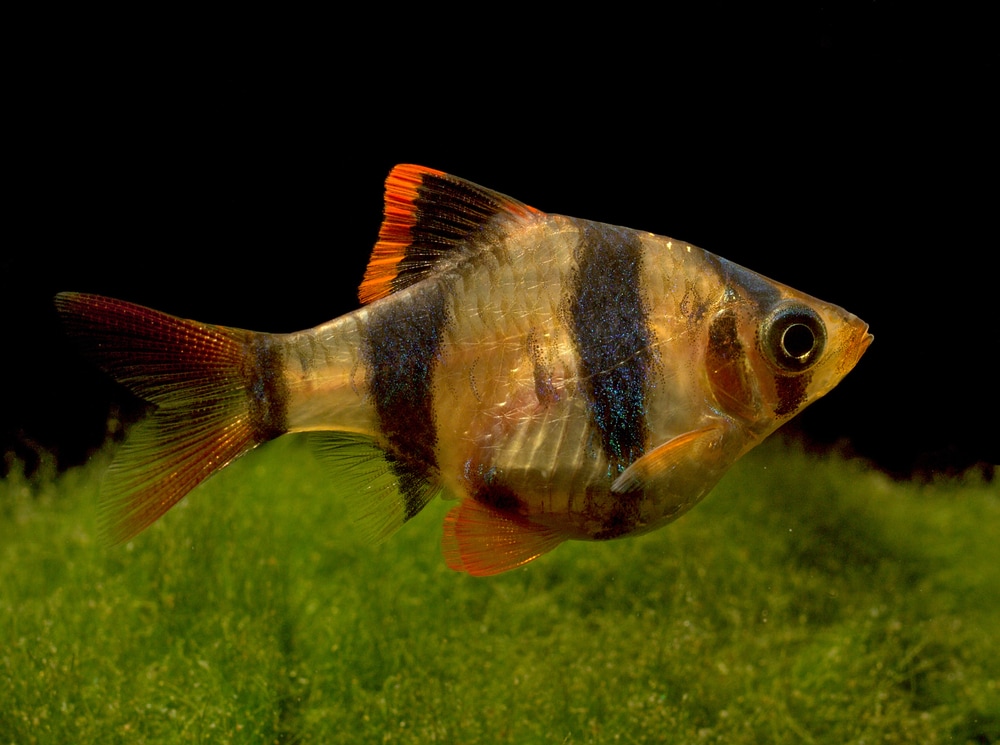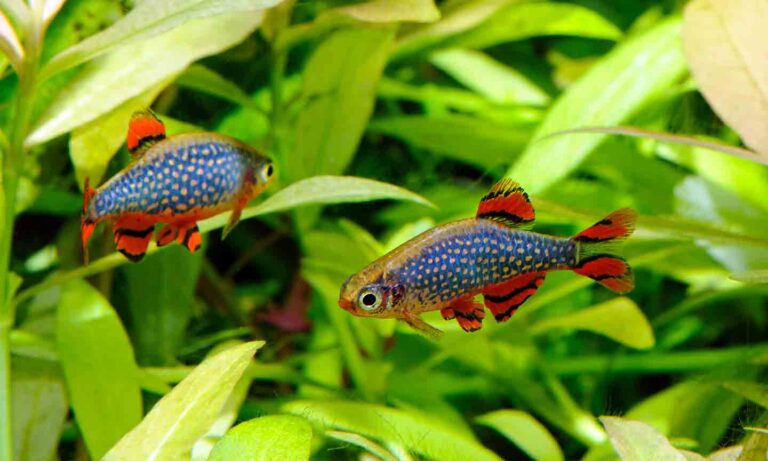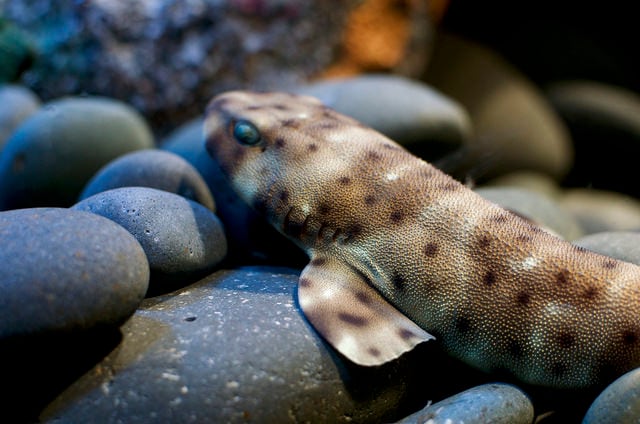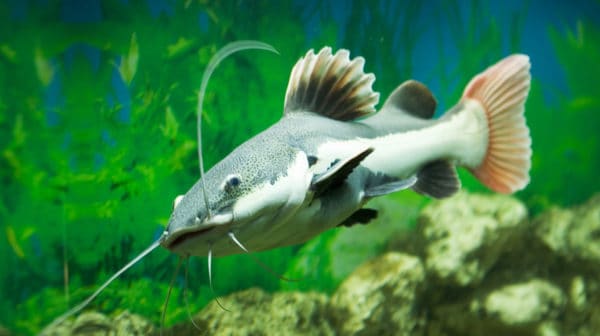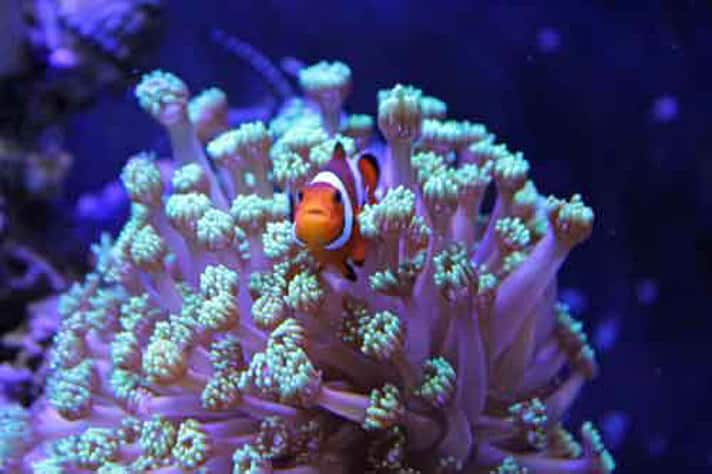The family Cyprinidae contains goldfish, minnows, carps, barbs and many more fish, both great and small. The favorite barbs kept in the tropical freshwater aquarium are, naturally, those with the most color and the best behavior. These would include the tiger (Puntius tetrazona), rosy (P. conchonius) and cherry (P. titteya) barbs. Although the term “barb” has only four letters, it covers a whole lot of fish, many of which are of no interest to aquarists because they get too big, have little color or just lack charm. Consider that the family Cyprinidae is one of the largest fish families, with about 194 genera and 2,070 species, and it’s no surprise they can’t all be superstars. The largest of the barbs is a Thai native, the giant barb (Catlocarpio siamensis), a 9-foot-long behemoth.
The Tiger Barb
This is one of my favorite aquarium fish. The tiger barb is a sporty-looking little fish with distinctive stripes, and red on the fins and nose. There is also a moss green tiger barb variety that looks great against a dark substrate with good light from above. Tiger Barbs are unlikely to outgrow their aquarium, because they reach about 2 1/2 inches at maturity. Natives of Sumatra and Borneo originally, the fish offered in pet shops are rarely wild caught today because they are one of those profitable species for fish farmers around the world. This is a highly active species that is usually kept in schools, which is the only way to ensure its good behavior in a community aquarium.
Without the distraction of a school containing at least six or eight of its fellows, the Tiger Barb can be a nippy nuisance to other fish. Because it cruises all levels of the aquarium, there is no respite for other species when one attempts to keep the Tiger Barbs in fewer numbers. In a good-sized school, however, it is a different fish entirely, more concerned with the interests of other Tiger Barbs than the fins of the Pleco on the glass. Even when Tiger Barbs are kept in a school, however, it is wise to avoid keeping them with slow-moving, long-finned tankmates, such as fancy Angelfish and betta fish. Some good tankmates besides other Tiger Barbs would be Clown Loaches, Red-Tailed Sharks, Cories, Plecos, Platies and many of the other common community fish. As long as there is a reasonable match in size and personality, there should be nothing to worry about because tiger barbs aren’t really homicidal but mischievous. Tiger Barbs are easy to keep, being content in the usual aquarium conditions. They prefer soft, slightly acidic water, but if properly acclimated they will tolerate pH values from 6.0 to 8.0. Their aquarium should be at least 30 gallons. It makes little difference if the plants are live or plastic.
The Tiger Barb is not known to be a plant beater, but there may be a bit of mayhem and untidiness when they choose to spawn. It’s more important to leave open swimming space than to have every inch of the aquarium decorated. Rocks and driftwood are attractive in virtually any aquarium, but are likely to be ignored by the tiger barb, which isn’t territorial. Tiger Barbs are good eaters. They aren’t at all fussy and will accept any aquarium food they can swallow. For well-conditioned fish, supplement their diet with live and frozen natural foods. Include fresh vegetables in the diet. Frozen peas with their skins slipped off are ideal.
Tiger Barb colors will pop out of the aquarium in appreciation. Adult Tiger Barbs will spawn in a community aquarium, but it is unlikely any of the eggs will escape being eaten. If you would like to breed Tiger Barbs, a separate aquarium is required. Ten gallons will suffice for one female and two males, which is the preferred ratio by fish farmers – ensuring that all of the 250 or so eggs are fertilized. To stimulate spawning, condition the fish well on live and vegetable foods for about two weeks before moving them to the spawning aquarium. Don’t be surprised if they begin to spawn prematurely in the community aquarium. The water in the spawning aquarium should have a pH of about 6.5, and the temperature should be about 76 to 78 degrees Fahrenheit. Java moss is a nice touch in the spawning aquarium because it protects the eggs from the parents turning around and eating them immediately. Choose a trio of the best-looking fish in your school. The males will be more brightly colored than usual, especially red around the lips and dorsal fin. The females should be larger than the males, especially round the middle. The fish will spawn, tossing the eggs into the plants and then ignoring them completely, other than to possibly eat them. The adults should be removed from the spawning aquarium as soon as spawning is complete. The eggs will hatch in about 72 hours at the higher temperature, and the fry become free swimming in 48 hours. They need the smallest of foods: infusoria, newly hatched brine shrimp, Artificial Plankton Rotifer (A.P.R.) and commercial fry food. Increase water changes and food size as the fry grow.
The Rosy Barb
This little gem is pinkish-red with silvery-flecked scales (which are quite large) on the sides. The dorsal and anal fins are tipped with black. There is a black spot on the tail. When they are in spawning mode, the male becomes deep red, and the female brightens up significantly. The females are a bit larger than the males and develop a rounded belly that is typical when egglayer females fill with roe. They usually grow to a maximum length of 5 inches.
The rosy barb is a native of India and the surrounding areas, where it is found in lakes and hill streams. They are well established in the fish aquarium trade and are available in both normal and long-finned forms year-round in any well-stocked aquarium shop. Though mutations do not generally produce improvements in fish, the rosy barb could be considered an exception – the long-finned form is quite attractive. There is a variety with a half-black dorsal fin that is also rather beautiful.
Rosy Barbs are hardy, and they can be kept in slightly cooler water than is usual for tropical fish. Temperatures of 68 to 72 degrees Fahrenheit are acceptable for this subtropical species. Rosy barbs do not have any special care requirements, but it’s worth noting they aren’t quite as boisterous as their tiger barb cousins. They are not wallflowers like the cherry barbs, either, but they do appreciate an aquarium without too much excitement. Rowdy cichlids or lone tiger barbs would likely harass them to death. Still, like the Tiger Barb, Rosy Barbs should be kept in schools, or they can be the death of many otherwise-suitable tankmates.
Schooling fish really do need to stay in a school – otherwise they can be found pestering and pecking at even larger fish until the aquarium is a crime scene. Other than this, your normal aquarium is fine – 30 gallons is a good size. The water should be soft and slightly acidic, although there is room for compromise where pH is concerned. Acclimated fish will tolerate relatively high pH levels. There is no need for extra aquascaping as there would be if territories were defended. Decorations in the aquarium are purely for aesthetic purposes. Fine-leaved plants are useful when breeding the fish, but otherwise aquascaping is for the aquarist, not for the fish. Open swimming space should be maintained, as rosies do like to stretch their fins. The Rosy Barb likes to root around in the gravel, which should be fairly fine and rounded.
As always, darker gravel not only accents the color of the fish but provides a sense of security that allows the fish to display its most beautiful coloration. Rosy Barbs stay around the middle and bottom of the tank, so it is best to keep the gravel well vacuumed. Water changes with aged water will keep the fish looking and feeling their best. Rosy Barbs feed on any of the typical prepared aquarium foods. They also actively consume a diet that includes worms, crustaceans, insects and plant matter. Rosy Barbs are as easy to spawn as any egglayer can be. There is really only one tricky part: The parents must be removed from the aquarium after the eggs have been laid because they will gobble up the eggs as soon as they have a hint of free-floating caviar in the aquarium. Spawning and rearing rosies is simple. Prepare a 5- or 10-gallon aquarium with aged water and some Java moss or a substrate of marbles to protect the eggs (eggs will fall down between the marbles, where they should be unreachable). Because these barbs are prolific, it may not be critical to save all the eggs, but without some protection, it is easy to lose all the eggs.
Condition the fish with high-quality food for about two weeks before placing one male and one or two females into the prepared spawning aquarium. Sponge filters are ideal for the spawning/rearing aquarium. The eggs are safe from being lost in the filter, and the sponge is host to abundant fine foods that will provide some of the first meals for the fry. Sponge filters are home to tiny rotifers, planaria and so on, and you will see the fry pecking at the surface of the sponge as soon as their egg sacs disappear. Courtship and spawning is much the same as with other egglayers, with the male shaking and shimmying to display for the female. When she is ready, she will release her eggs for him to fertilize, and the eggs will drop to the bottom or into the leaves of the plants. You may miss the spawning act, but you will see when the females are slimmer. Remove the adults immediately. Look for clear eggs less than one-eighth inch in diameter.
The eggs hatch in about 48 hours, and you will see glasslike slivers hanging out at the waterline. Newly hatched fry cannot eat until they are free swimming and their yolk sacs have been absorbed. Then, you will need to provide very fine food, or they will starve to death. Once they are free swimming, you will likely see fry ferociously tearing at the sponge filter to capture the fine rotifers living there. It is amusing to see such tiny creatures chowing down on food we can’t even see without magnification. The sponge filter food will not last long with this hungry horde, and you must be prepared with some A.P.R. and/or newly hatched brine shrimp. Infusoria works well, too. It is best to try all these foods and keep plenty of well-aged water on hand for those very necessary water changes. That’s about all you need to raise fish fry. It is quite an accomplishment to spawn and raise egglayer fry to maturity, no matter how easy aquarium authors tell you it will be.
The Cherry Barb
The Cherry Barb is the mannerly fish in this article. These Sri Lankan natives are perhaps the most reserved of the three barbs mentioned here. Although they can be quite outgoing, they don’t care for bright lights or silly tankmates, and they will shy away from the action if they are not pleased with conditions. You will know when they are not happy because they will hang out alone in a corner of the aquarium. One major difference with the cherry barb is that it is still being widely collected in the wild (there are some new intensely colored forms). It is commercially bred, as well, but there is a danger Cherry Barbs may be overfished in Sri Lanka. This country enjoys a thriving trade in tropical freshwater fish, both wild caught and commercially bred, so some care is in order regarding the collection of desirable fish. Whereas tigers and rosies are from rather fast-moving waters, the Cherry Barb is found predominantly in clear water in shaded shallows. The female is a light iridescent pink, while the male is darker. Both show black and gold bands along the length of the body. The tail and anal fins are cherry red, with the colors really turning on when the fish are kept in proper conditions and are preparing to spawn.
Cherry barbs will grow to 2 inches in length. The aquarium for Cherry Barbs is similar to that of tiger and rosy barbs. They do well in a wide range of temperatures and water chemistries. Cherry Barbs will appreciate a 30-gallon aquarium, but a trio of two females and one male will thrive in a 5-gallon planted aquarium all by themselves. This could be an ideal species aquarium, as there would likely be a lot of spawning, and they would stay colored up most of the time. In a community aquarium, you would probably want to have at least six cherry barbs, but don’t be surprised if they get a little nasty with each other at times. Cherry Barbs are omnivores that will accept prepared and live fish foods without hesitation. Like the other barbs in this article, vegetables are appreciated. A piece of zucchini (without the seeds) that has been in the microwave for one minute and chopped will disappear in no time from a aquarium with any of these barb fish. They love all softened vegetables.
Cherry Barbs are prolific egglayers that will produce as many as 300 eggs at a time. This is a whole lot of eggs for such a small fish, but because the parents have nothing to do with them after the eggs are laid (except eat them if they can), it’s not like they do too much hard work. Set up a breeding aquarium with Java moss if you want to protect the eggs. Spawning and fry development follow much the same course as with tiger and rosy barbs, except that the fry are even smaller than those produced by their larger cousins. Offer green water to the young, because they are too small to eat anything larger. When the fry have grown, even if you don’t see them pecking at brine shrimp nauplii, you’ll know they’re ready to change over to this larger fish food, because the bellies of the fry will turn pink when filled with the shrimp. At this point, you can stop providing green water.
The Gold Barb
The Gold Barb is a pretty little fish that is a honey yellow with red fins. It also sometimes can be seen with a black spot right before the tail and on the back. One interesting aspect about this species is, unlike most other barbs, the Gold Barb is a very peaceful fish and is not known for being a fin nipper. They typically grow to around 2 inches in length and are best kept in large groups. If you have a large tank that can accommodate a large community of gold barbs, consider acquiring from 6 to 12 fish for your tank. The gold barb does best in a planted tank with dark gravel, and rocks and driftwood for them to take refuge.
The Gold Barb prefers a pH between 6.8 to 7.5 and is compatible with a water hardness ranging from soft to very hard. The Gold Barb also likes cooler water temperatures between 65 and 75 degrees Fahrenheit but can tolerate higher temps of up to 80 degrees. You can feed the gold barb a variety of fish foods and will readily accept most foods, including flake foods, freeze dried foods, brine shrimp, blood worms and black worms. Live tubifex worms are generally not recommended as they can introduce disease into an aquarium, but freeze dried are ok. Since the gold barb lives in the lower half of the water column, ensure that you supplement any surface feeding with slow sinking fish foods in the event that other fish in the tank are voracious eaters.
If you wish to breed Gold Barbs, prepare a bare 10 gallon aquarium with aquatic plants that have fine leaves. Java moss or Myriophyllum are a good choice. Keep the temperature at 75 to 78 degrees Fahrenheit. In separate tanks, feed the males and females with heavily for a few weeks and then place them in the tank in the evening. They should spawn, with the female scattering her eggs into the plants. Once the eggs are expelled, remove the fish or the eggs will be eaten. The eggs will hatch in a few days, and when they become free swimming, feed them infusoria, powdered egg layer fish food, or microworms. Follow this in a week or two with baby brine shrimp.
Posted by: Chewy Editorial
Featured Image: Via Shutterstock/Dan Olsen
Share:
